Coal prices double in a week as buyers baulk at Russia
Coal prices have more than doubled over the last week as the Ukraine crisis rocked energy markets, with buyers in Europe and Asia scrambling to find alternatives to Russian coal.

Business
Don't miss out on the headlines from Business. Followed categories will be added to My News.
Coal prices have more than doubled over the last week as the Ukraine crisis rocked energy markets, with buyers in Europe and Asia scrambling to find alternatives to Russian coal.
Australian thermal coal prices broke through $US400 ($548) a tonne this week, promising windfall profits for local producers. LNG prices on Asian spot markets are also up by 50 per cent amid the threat of disruption to Russian gas supplies.
The promise of windfall profits has led to a surge in the share prices of ASX-listed coal producers. Yancoal closed up 10.9 per cent to $4.75, with Whitehaven up 10.6 per cent to $3.96 and New Hope Corporation up 4.3 per cent to $2.93.
Yancoal is now up almost 50 per cent in a week, with Whitehaven up 25 per cent over five days.
The coal spike comes as buyers in Europe and Asia desperately look for alternative sources of supply to Russian coal miners.
While no sanctions have directly targeted Russian energy exports, industry sources say banks in Europe and Asia have effectively put a shadow ban on Russian coal miners by refusing to extend letters of credit to cover sales from Russian sources, substantially increasing the risks for traders.
The Australian reported on Thursday that the federal government had instructed its trade officials to open talks with major coal producers to find spare cargoes for Poland and big trading partners in Asia amid a scramble to find alternatives to Russian coal.
Italy, Croatia and Bulgaria are also said to be in the market for additional tonnes to feed coal-fired power stations, amid talk Italy is about to announce to return a mothballed coal plant in Trieste into its grid.
But relief from Australian sources is unlikely, given most are already running at full capacity to meet existing contracts. That supply may be facing fresh problems if the NSW Hunter Valley coal district and coal terminals at Newcastle bear the brunt of the massive deluge that has flooded southern Queensland and NSW.
Thermal coal futures suggest European buyers could still be paying more than $US400 a tonne for the rest of the year, according to Wood Mackenzie principal analyst Rory Simmington. “Some buyers in Japan and Europe have already indicated they are looking to replace Russian supply, and non-Russian thermal coal in Europe is attracting a significant premium over Russian material,” he said.
“Metallurgical coal, used in coke production and injected into blast furnaces, spiked with PCI prices – a key Russian export – leaping to an unprecedented levels nearing $US400 a tonne.”
But despite Russia showing no sign it will back down from its invasion of Ukraine, and mass shelling of civilian targets raising the prospect of even tougher sanctions against the regime of Vladimir Putin, Mr Simmington said a return to more normal coal buying patterns was likely.

“Heavy reliance on Russian coal imports in the current tight market means a prolonged cut-off would bring damage to both Russia and importing countries and is unlikely in Wood Mackenzie’s view,” he said.
“Together, Europe, Japan and South Korea imported around 90 million tonnes of Russian thermal coal and 25 million tonnes of Russian metallurgical coal in 2021. These coals are predominantly high energy thermal coal and PCI and cannot conceivably be replaced in the currently tight global supply market.”
Newcastle thermal coal, the benchmark for seaborne supplies in the Asia-Pacific region, saw futures jump 42 per cent to $US446 a tonne, more than double the levels from last Friday, and up by more than $US140 in a single session.
Russia is the world’s third largest exporter of coal and its invasion of Ukraine and subsequent sanctions are expected to crimp supplies to major buyers in Asia including China.
It supplies about 30 per cent of Europe’s coking coal needs, and about 70 per cent of European thermal coal imports, according to WoodMac figures.
The Ukraine crisis is the latest of a series of disruptions to the international coal supplies.
Indonesian government restrictions on exports hit the market in January, and the La Nina weather pattern had caused flooding and infrastructure bottlenecks in Australia, which was also hit by pandemic-related labour shortages, Shaw and Partners analyst Peter O’Connor said.
“The above events combined to push thermal coal prices to what were then record highs in September and October 2021.
“The recent moves are most certainly of a geopolitical nature,” Mr O’Connor said.
LNG prices have also been soaring, given growing uncertainty over exports from Russia, the world’s fourth largest exporter of the fuel.
Spot prices for April surged to $US48.44 per million British thermal units, based on the Platts JKM index, with the 50 per cent jump the largest on record.
The current price move spurred by the conflict is “unprecedented”, according to broker Bernstein.
“Already there is news being reported that some LNG buyers are beginning to cut back Russia LNG imports as sanctions intensify and small importers have had trouble procuring Russian LNG given the financing restrictions. Relative to anything in recent history, including the Fukushima disaster in Japan, the current price moves are unprecedented,” Bernstein analyst Neil Beveridge said.
The frenzy among buyers to grab gas volumes could lead to hugely lucrative shipments by Australia’s top LNG exporters like Woodside Petroleum, with 20-25 per cent of its LNG production linked to European gas or spot LNG prices.
Australia’s LNG exports are already forecast to more than double to $63bn this financial year as oil-linked contract prices surge and the rise in spot prices may further fatten the nation’s revenues from the sector.
Russian pipeline gas accounts for a third of European gas supply but LNG supplies can only meet part of the shortfall given much of the production is already contracted to utilities in Asia.
West Australian, Queensland and Northern Territory producers would benefit from prices in Asia tracking those in Europe, although distances meant relatively little supply would be sent from Australia to Europe, Bernstein said. “Last year, Australia overtook Qatar as the largest LNG exporter in 2020 on the ramp-up of several LNG projects, while Qatar remained a close second. Australia, however, is distant from the European market, and we do not expect to see significant flows to Europe.”
More Coverage
Originally published as Coal prices double in a week as buyers baulk at Russia




